
The Inaugural Connective Holocaust Commemoration Expo 2025
By Mel Poluck
We built a games arcade, an exhibitor hall, set up various exhibitions and VR suites, ran a mini project hack, showcased work-in-progress, learnt new skills through workshops, engaged in debates and discussions, networked, hosted ‘let’s play’ sessions and went to the beach together. This was the inaugural Connective Holocaust Commemoration Expo 2025. Why did we do it?
One of the overarching aims of the Landecker Digital memory Lab is to create a community of individuals and organisations working in the field of digital memory that cuts across traditional silos, nationalities and disciplines.
To this end, we are convening a series of three international events, starting with the Connective Holocaust Commemoration Expo 2025, held at University of Sussex last month. After months of intense planning and preparing, on Tuesday 24 June, as delegates began streaming through the doors of the Jubilee building to the registration desk, it was heartening to see attendees arrive from so many affiliations and countries.
There were representatives from more than 30 countries among Expo participants, including student ambassadors, from across the Middle East, from Latin America, North America, Europe and Asia.
Setting the tone
We wanted to create an event that fused a conventional, academic conference with a more hands-on, industry-style exhibition.
It’s rare that academics and educators get in the same room as filmmakers, digital creatives and heritage professionals, especially in the context of Holocaust memory. So, we wanted to provide different ways to listen, learn and interact with colleagues and counterparts that would appeal to all audiences.
After all, one of our founding beliefs is that the Holocaust memory and education sector needs to learn from existing practice, rather than duplicate effort with each new digital project. Delegates had so many expectations – and the huge amount of positive feedback received suggested many of these were met!
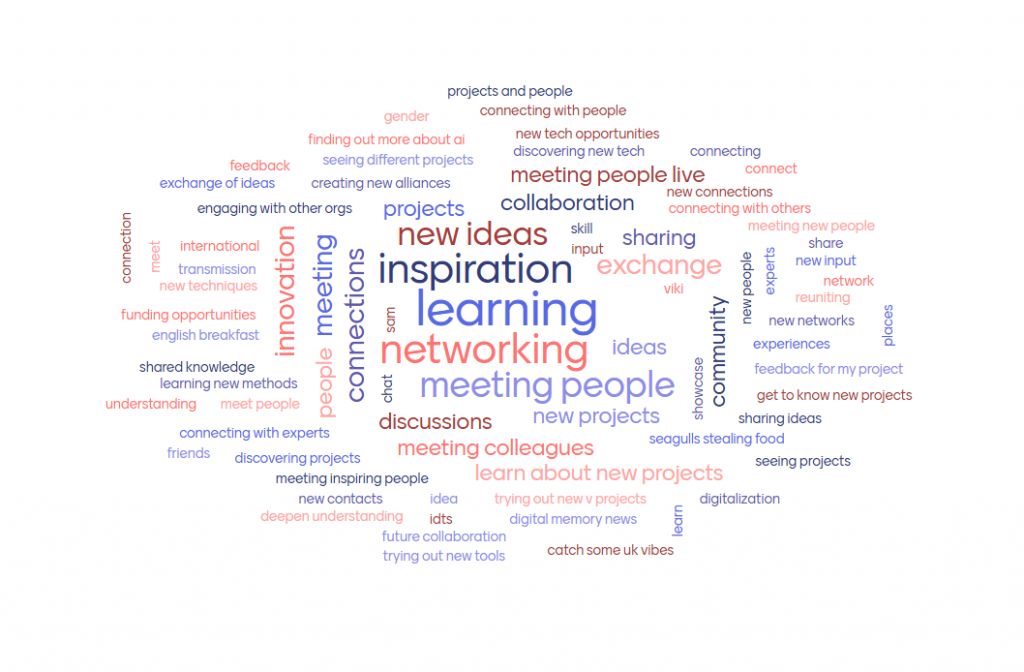
Expo 2025: Poll feedback: ‘what do you hope to gain from the event’?
We capitalised on these opportunities to make sure everybody had the chance to get the best from the diverse disciplines and standpoints by mixing up the styles. For example, keynotes took place in traditional lecture theatres while conversations continued in the exhibition hall where projects were demonstrated, and academic panels went on alongside ‘let’s play’ sessions, project showcases, and hands-on skills workshops.
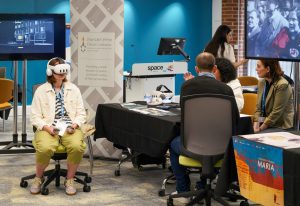
VR demo in the exhibition hall
Over the three days, delegates were invited to drop in to play in the games arcade, showcasing some 13 games from seven creators and producers, including Voices of the Forgotten’s Holocaust Museum inside Fortnite as well as games from indie studio Charles Games, Paintbucket Games, Gathering the Voices, the #LastSeen Project, Sobibor AR from the Los Angeles Holocaust Museum, and a demo of Normandie from game designer Sam Butin.
“You did an excellent job organizing and taking care of every detail. It was an exceptional opportunity to bring together people from so many different backgrounds and to create a truly one-of-a-kind event”
– Expo 2025 participant, comment on LinkedIn.
Official opening
We were honoured that welcome remarks were given by University of Sussex’s Vice Chancellor and President Prof. Sasha Roseneil, and Executive Dean of the Faculty of Media, Arts and Humanities Executive Dean Prof. Cornel Sandvoss and Johannes Rudloff, Grants Manager from our funder the Alfred Landecker Foundation in Berlin.
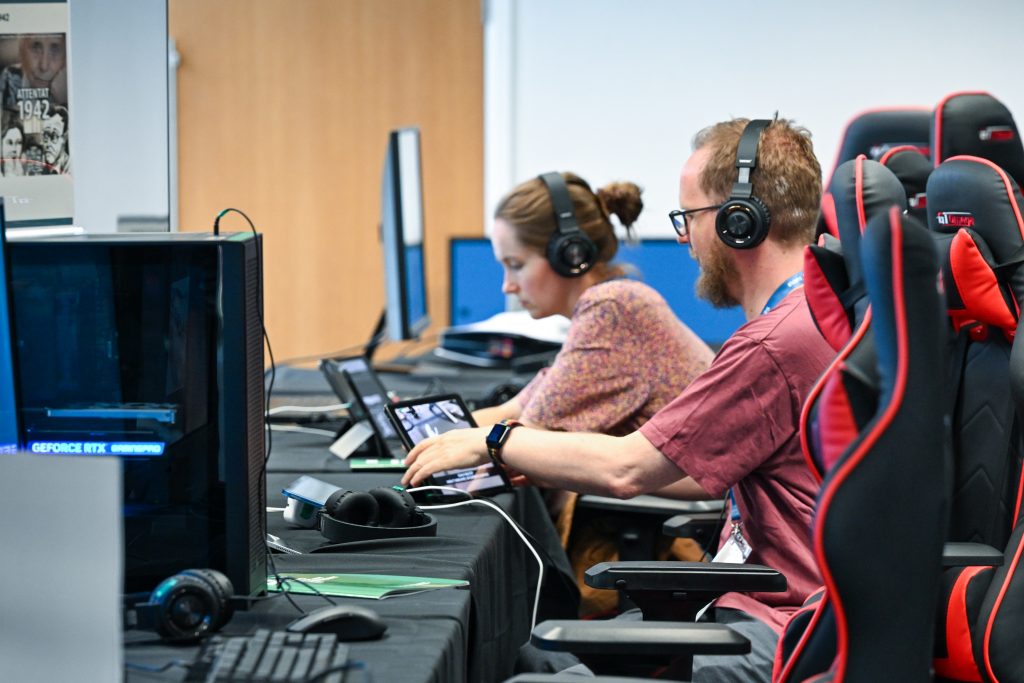
The games arcade
The official opening was particularly meaningful for the Landecker Digital Memory Lab team, as it doubled as the launch of our Digital Memory Database (beta version). One of our flagship resources, the database will collect the world’s digital Holocaust memory projects enabling users to view them as video walkthroughs and listen to interviews with those who created them, among other features.
It is due for public launch in early 2026.
Following an introduction by Lab Director, Prof. Victoria Grace Richardson-Walden, our Research Fellows Dr. Ben Pelling and Dr. Kate Marrison described the work we are doing to index, catalogue and present the data on this new platform (read more about it in this blog) and delegates had the chance to give their feedback on the platform during the whole event.
Find out more about some of the digital projects we are including and about the database’s technical development.
If you are involved in a digital Holocaust memory project, work at a Holocaust organisation with an online presence, and/or are responsible for digital strategy in this context, please do complete our research survey here. Your response will help us map global practice, and we would love to invite your team to record a walkthrough and interviews.
The team has just finished completing a tour of the database, user–testing it at the Max and Hilde Kochmann Summer School for PhD students in Jewish, Holocaust and Israel Studies; the British and Irish Association of Holocaust Studies conference, and the Memory Studies Association’s annual meeting in Prague.
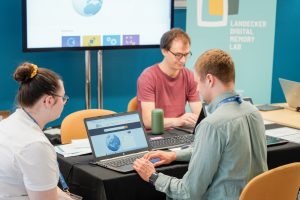
User testing the Digital Memory Database in the exhibition area
All the feedback they gather will inform the next stages of development. These user workshops are essential to the development of the database, which we want to make with communities rather than just for them.
‘Between fact and fiction’
Dr. Eva Pfanzelter’s keynote ‘Pixels and Hashtags of the Past: The Holocaust in the Digital Age’ provided an extraordinary overview of the history of digital Holocaust memory and set the backdrop for the entire event.
She described this time as a “crucial moment” as “memory is undergoing radical transformation” since the early days when the digital began to disrupt the landscape of Holocaust remembrance.
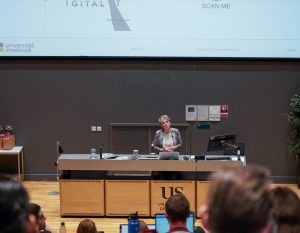
Eva Pfanzelter, Uni of Innsbruck, gives her keynote talk
Dr. Pfanzelter, from the University of Innsbruck, described the boundaries of memory between public and private, and collective and individual, as “blurred, even crumbling” and, somewhat concerningly, told the audience: “right now we’re in the middle of something between fact and fiction.”
She traced digital Holocaust memory across four phases, illustrated with the distinct tensions and milestones each brings, from the pre-internet phase, including CD-Roms (we exhibited Anne Frank House: A House with a Story on an authentic 90s Mac at the Expo, often cited as one of the first digital Holocaust memory projects) to the dawn of early multimedia projects, through the inception of Wikipedia and social media (moving us from “multimedia to multi-modality” and into a “prosumer” age), up to the recent the pandemic and today’s “digital wilds”, encompassing VR and AR.
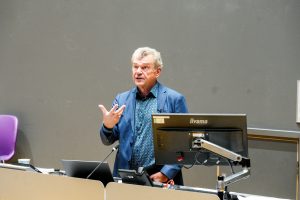
Paul FMJ Verschure, SPECS Lab and Future Memory Foundation, gives his keynote talk
The second keynote, on day three, looked towards the future for digital memory through a neuroscience lens. In ‘Conserving and Communicating the Indescribable: Attempts to Shape the Future Memory of the Holocaust and Nazi Crimes’, Prof. Paul F.M.J. Verschure from SPECS Lab, Alicante Institute of Neuroscience, Universidad Miguel Hernandez de Elche and the Future Memory Foundation, called for the creation of a code of conduct for those working in digital Holocaust memory, in light of his view that “little attention has been paid to defining and achieving meaningful learning outcomes”.
Both keynotes were livestreamed and are available online on our YouTube channel.
Collaborative environment
There was a real sense of collaboration during the whole event, reflected in the way that many delegates participated in more than one capacity. For example, Gathering the Voices and Glasgow Caledonian University ran a practical workshop on creating serious games (with Dr. Angela Shapiro and Hamid Homatash respectively), showcased a paper prototype of a potential computer game, with Dr Ben Shepherd while their games ‘Marion’s Journey’ (made by Chimera Tales) and ‘Suzanne’ (made by undergraduate computing games students ) were on display in the games arcade for anyone to play.
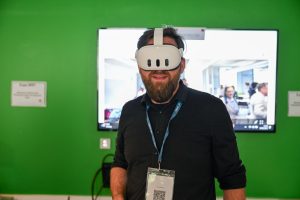
Expo participant tries a VR experience
And, in the spirit of the Expo, we welcomed work-in-progress, as well as fully formed projects, exemplified in the exhibition hall by Ravensbrück Memorial, who brought a sneak peek of their digital exhibition ‘A Few Barracks Further’, currently in development.
But this aspect of the event was perhaps best illustrated by the ‘Project Mini-Hack’.
A special lunchtime session to which we invited guests from the digital creative industry, we convened three groups, each led by a representative from a Holocaust-related project, who had previously applied for a place by winning a competition earlier in the year.
They were joined by digital creative media producers, academics and educators in a space designed to facilitate cross-collaboration between sectors, and be a catalyst for lasting relationships between tech, digital and creative professionals and the heritage space.
There was a palpable buzz in the room, as each tightly timed part of the session saw groups hash out ideation, pain points, costings, ethical considerations and technical specifications. Each group presented their under-development project for which other cross-sector colleagues in their ‘team’ could help to create a ‘prototype lite’ in just two and a half hours.
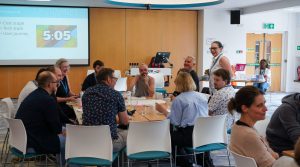
Project mini-hack
Each team’s input fed directly into the project owners’ plans, shaping how these Holocaust commemoration projects could develop from a technological, storytelling, and engagement perspective.
Check out this video for a flavour of this innovative session, with feedback from participants, whose comments included: “Great for generating new ideas”, “Amazing to have different talents around the table discussing what can happen in terms of a transmedia interactive experience”, “Really informative to learn from different practitioners and see how things are being done in different sectors.”
We now aim to nurture any collaborations that have emerged as a result of the session, through our free consultancy arm. Contact us if you would like to make use of our expertise to support the development of a digital Holocaust memory project.
“Such an inspiring event, we all learned so much! Thanks to the team for organizing!”
– Expo 2025 participant, comment on LinkedIn.
Initiating discussion
To get a sense of the packed, cross-sector and varied programme, here’s a glimpse of some sessions from the three days:
- A masterclass called ‘Bearing Witness: The Future of Holocaust Memory Through Immersive Technology’ with Darren Emerson, Company Director at East City Films which also had a VR film suite set up over the three days of the Expo showing their trio of films, created in partnership with the Illinois Holocaust Museum & Education Center, ‘The Journey Back’ including Letters From Drancy
- Mapping the Past and the Production of History: Low-Tech, Participatory Approaches to Documenting Holocaust Sites and Conflict Landscapes, a hands-on workshop facilitated by Osnabrück University (find out more about their Expo experience here)
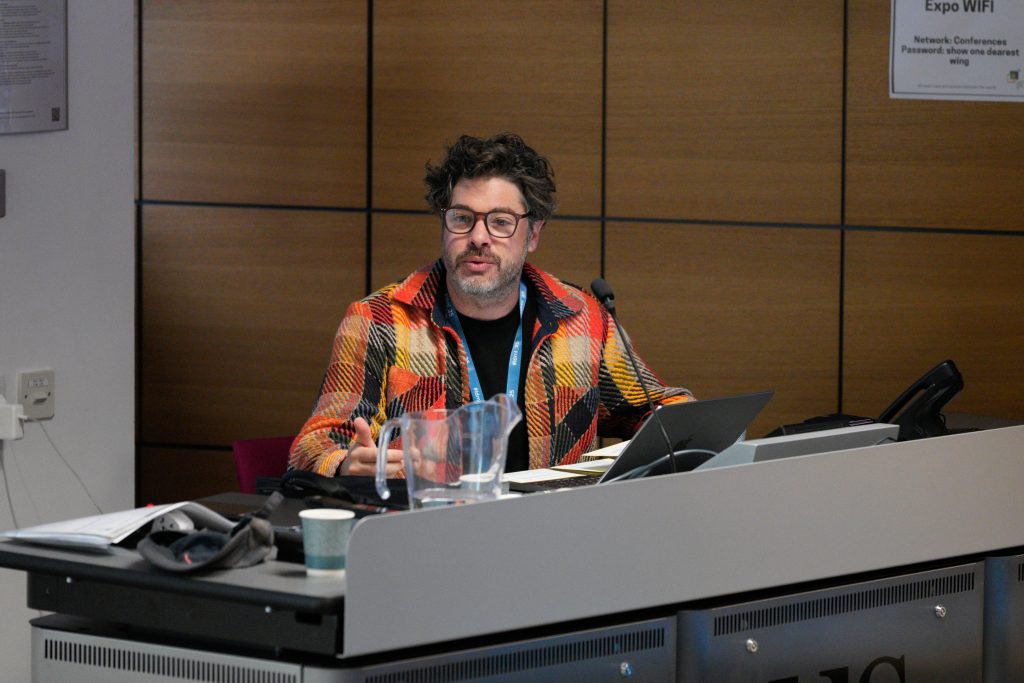
Darren Emerson, Company Director, East City Films gives a masterclass on VR films
- Maria Schmidt, Maryia Aksiuchyts, and Marietta Ziel from Educat Kollectiv, Germany, presented on ‘Cultures of Remembrance in Dark Times’, a project from this activist-artist group whose objective was to critically examine how the memory of World War II, National Socialism, and resistance varies across Europe
- A ‘Let’s Play’ session on the game ‘Remember. The Children of Bullenhuser Damm’- a game supported by our funder Alfred Landecker Foundation – with games designers Jörg Friedrich from Paintbucket Games, Dr Lucas Haasis from Gamelab at Oldenburg University, and Markus Basserman from the Foundation of Hamburg Memorials and Learning Centres Commemorating the Victims of Nazi Crimes. This was one of five ‘Let’s Play’ sessions, chaired by Germany-based games and memory expert, Christian Huberts
- A showcase called ‘Forget What You Know: Experience as Inoculation Tactic’ with Ellen Pilsworth and David Brauner from University of Reading, and Rachel Briscoe and Daniel Barnard from experimental art and theatre company Fast Familiar.
Continuing Conversations
The knowledge exchange carried on over lunch during structured networking sessions.
One of our official collaborators, iRights Lab’s facilitated the first of these, which was led by Platform Manager Anne Lammers who introduced new and existing members to the Digital Collective Memory Platform, a space for the international memory community to share practice and use as a springboard for digital and in-person collaboration and connection.
We hope that delegates continue to use this valuable resource to develop new ideas sparked at the Expo.
Another networking session used the project #GeradeJetzt / #EspeciallyNow as a springboard to co-create a future, global social media campaign. This was hosted by Dr. Iris Groschek and Clara Mansfeld from the Foundation of Hamburg Memorials and Learning Centres Commemorating the Victims of Nazi Crimes.
There was a rich mix of parallel sessions on each day of the Expo – to the extent that delegates were overheard saying they struggled to choose!
For example, the Leibniz Supercomputing Centre, Ludwig Maximilian University of Munich and Chemnitz University of Technology (TU Chemnitz) brought their perspectives on maintaining and developing interactive digital testimony, with input from Dr. Daniel Kolb, Fabian Heindl and Antonia Friebel respectively.
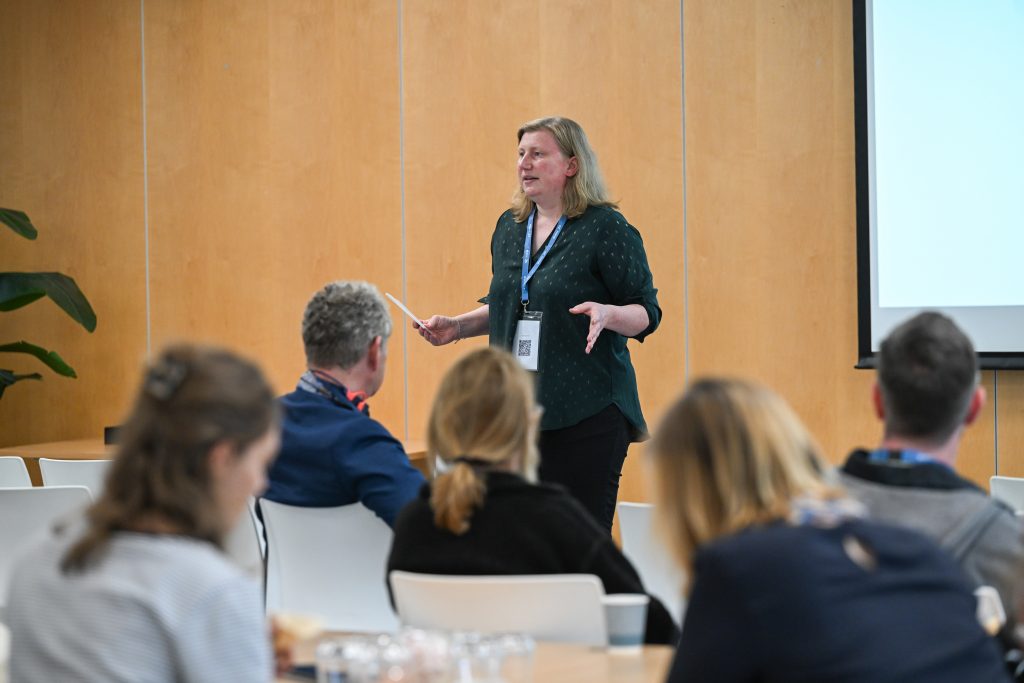
Dr. Anne Lammers, Project Coordinator for iRights.Lab’s DCM platform facilitates a networking session
The EU-funded project Memorise presented on digital tools and formats that offer access to former camp sites. Their initiative is aimed at groups in educational contexts, researchers and visitors. Memorise participants represented at the Expo included Bergen-Belsen Memorial (Stephanie Billib, Dr. Richard Khulusi, and Marc Ellinghaus), Radboud University (Aliisa Råmark), creative digital design company Fluxguide (Cathrin Steiner and Paul Sommersguter) and Hebrew University of Jerusalem (Esther Rachow and Prof. Tobias Ebbrecht-Hartmann).
At the heart of our focus on interdisciplinary discussion at the Expo was the launch of our new open access publishing space Digital Memory Dialogues – starting with the provocation: “Can the Holocaust Be Made Playable?”
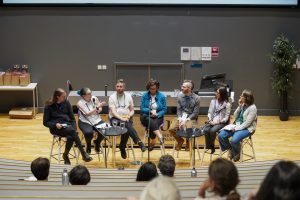
Digital Memory Dialogues launch and discussion on computer games and the Holocaust
Dialogue I invited game designer Jörg Friedrlich from Paintbucket Games, Silvina Fernandez-Duque, Russ Sitka and David Klevan (the United States Holocaust Memorial Museum), Dr. Tabea Widemann (Zeppelin Museum) and Dr. Alina Bothe (Freie Universität Berlin) to not only respond to this question, but to review each other’s responses and then come together for a public discussion on the Wednesday afternoon at the Expo (except David, who could not join us). Dr. Nick Webber (Birmingham City University and the Historical Games Network) kindly stepped in, to guest chair the session.
You can watch the whole Dialogues session on our YouTube Channel here.
Following the launch, an international array of Holocaust museum and memory professionals shared their experiences of using social media to engage audiences.
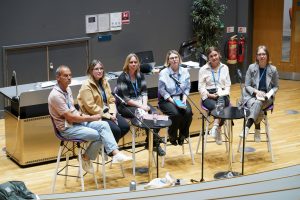
Social media roundtable
Chaired by the Lab’s Dr. Kate Marrison, the roundtable included Ton Mascini (Anne Frank House), Dr. Iris Groschek (Foundation of Hamburg Memorials and Learning Centres Commemorating the Victims of Nazi Crimes), Laura Nicolli Kullock (Holocaust Museum Curitiba, Brazil), Marie Zacher (SHOAH STORIES project), and Katja S. Baumgärtner (associated at the Selma-Stern-Center for Jewish Studies).
You can watch this discussion also on our YouTube Channel here.
Digital Deep Dive
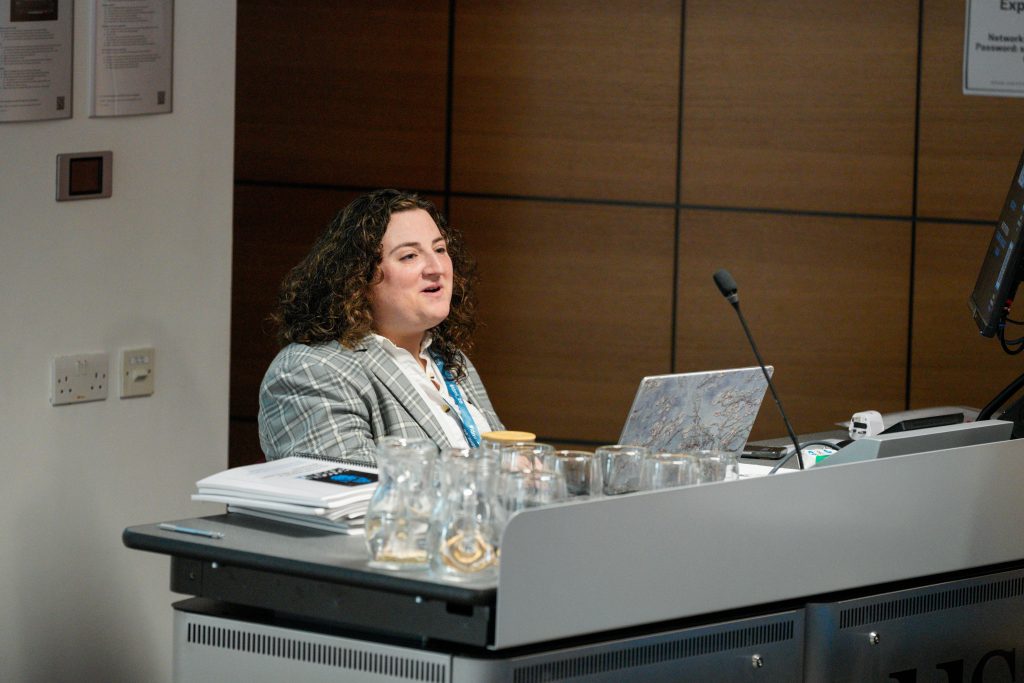
Sarah Klein from Holocaust Museum LA
We thought it was important to include ‘showcase’ sessions to make sure participants could really delve in to a range of digital projects at different stages, from initial ideas to user testing. Examples include:
- Sarah Klein, from the Holocaust Museum, Los Angeles introduced attendees to an AR app that aims to enhance museum education and create a deeper understanding. Sarah explained that the app provides access to digital primary sources from Thomas Blatt, a Sobibor death camp survivor. “By integrating AR technology,” said Sarah, “Holocaust heritage and education experts can extend access to crucial primary sources, while maintaining their authenticity in historical education and fostering a more dignified and humane world”.
- An in-depth look at a huge digital transformation project from the Weiner Holocaust Library team in London, with Christopher Gilley, Yasmin Gledhill, Stefanie Rauch and Barbara Warnock who covered the development of digital infrastructure to host digital images and the use of digitised resources in its education programme.
- The iWalk project – video testimony-based local history walks which use an app to unfold local Holocaust history on the go, combining historical text alongside video testimony of survivors and witnesses and a backend infrastructure from the USC Shoah Foundation’s Visual History Archive. This example was focused on Hungary and presented by Monika Mezei and Gabriella Komoly from the Zachor Foundation. They explored how the app has been designed to be used in the street but continued in the classroom, as features encourage critical thinking questions that the students can record in the app and share with teachers.
- The multimedia and multi-platform project A Dangerous Journey, presented by Andrés Bartos Amory and Lucija Stojević from Noon Films.
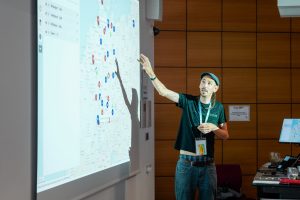
Jan Schenck explains the open data Verbrannte Orte (burnt earth’) project
- Žanis: Through Our Eyes, a multi-plot documentary for virtual reality was presented by Raivis Sīmansons from Žanis Lipke Memorial in Latvia and Cory McLeod from creative agency Rise and Shine & Partners in the US (read our blog from Lab Research Fellow Dr Kate Marrison based on her fieldwork at the memorial). Attendees could also view the whole experience at the Expo.
- An Open Data project about the Places of the Book Burnings in 1933, with Jan Schenck from the Verbrannte Orte Memorial Project in Germany.
The evening entertainment gave delegates a chance to relax after a busy schedule.
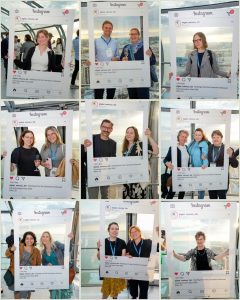
Evening entertainment at the i360 on Brighton beach
On Wednesday, we all enjoyed views across the sea and over the downs during an ascent of the i360 viewing tower before having dinner on Brighton beach.
Forming community
The lessons we have learned will feed into the next Expo, indeed plans for the next one in Germany in 2027 have already begun, but the successes of the event are down to multiple people, not least all the participants that made it a forum for innovation, progress and academic discussion.
We are extremely thankful to all participants, without whom the event would not have been able to happen. A special thank you goes to the Alfred Landecker Foundation, our student ambassadors, official partners and collaborators, the security team, session chairs, cleaners, registration staff, the camera crew and the technicians.
“The three days just flew by, but so many conversations started, continued and have not yet been finished. I have taken much with me and it will take some time to sort through. Right now: congratulations!”
– Expo 2025 participant, comment on LinkedIn.
But while we celebrate the successes of the Expo, when we assess the outcomes of the event, we know it is important to zoom out and return to the core of what the Lab is and why it exists.
We see a future in which global Holocaust memory and education is shaped by fitting digital strategies, informed by digital literacies, and supported by appropriate technology. We set out to shape this idea of the future by creating a community informed by:
- transdisciplinary exchange
- rigorous research
- an inclusive, global outlook
We hope that with the Expo, we’ve started to create this global community and sown the seeds for interdisciplinary exchange. As participants packed up ready to leave on Thursday evening, we asked them to sum up the event in one word.
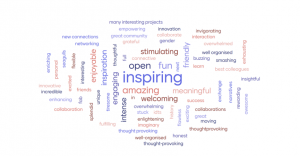
Mentimeter poll: sum up the Expo in a word
We are now really looking forward to the forthcoming exchanges and enhancement of knowledge this will bring.
We are indebted to our funder the Alfred Landecker Foundation for supporting us to make the Expo a reality.
For more on the Expo, follow us on LinkedIn, Bluesky, Instagram and Facebook.